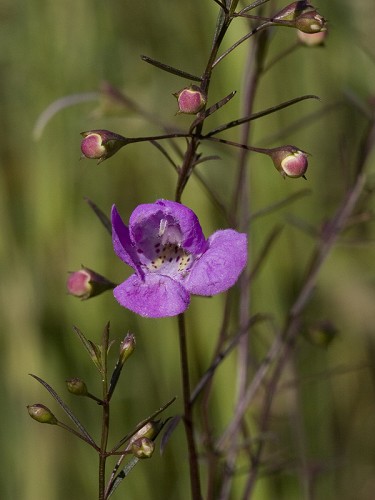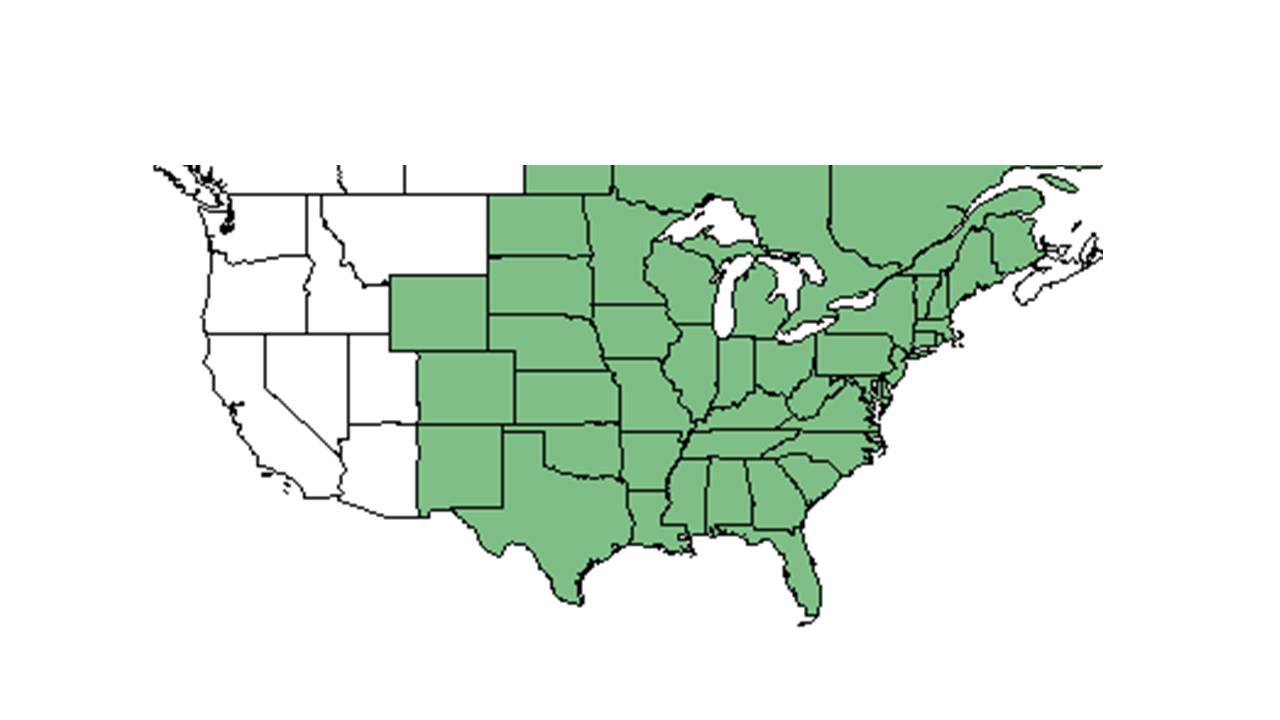Agalinis tenuifolia
| Agalinis tenuifolia | |
|---|---|

| |
| Photo by John R. Gwaltney, Southeastern Flora.com | |
| Scientific classification | |
| Kingdom: | Plantae |
| Division: | Magnoliophyta - Flowering plants |
| Class: | Magnoliopsida - Dicotyledons |
| Order: | Lamiales |
| Family: | Orobanchaceae |
| Genus: | Agalinis |
| Species: | A. tenuifolia |
| Binomial name | |
| Agalinis tenuifolia (Vahl) Raf. | |

| |
| Natural range of Agalinis tenuifolia from USDA NRCS Plants Database. | |
Common names: slender gerardia; slenderleaf false foxglove, slenderleaf agalinis
Contents
Taxonomic notes
Synonyms: none [1]
Varieties: Agalinis besseyana Britton; Gerardia tenuifolia (Vahl) Rafinesque var. leucanthera (Rafinesque) Pennell; Agalinis tenuifolia (Vahl) Rafinesque var. macrophylla (Bentham) Blake; Agalinis tenuifolia var. parviflora; Agalinis tenuifolia (Vahl) Rafinesque var. polyphylla (Small) Pennell; Agalinis tenuifolia (Vahl) Rafinesque var. tenuifolia; Gerardia polyphylla Small; Gerardia tenuifolia Vahl ssp. macrophylla (Bentham) Pennell; Gerardia tenuifolia Vahl ssp. polyphylla (Small) Pennell[1]
Description
Agalinis tenuifolia is an annual plant that is parasitic to the roots of grasses and other herbs. The stems are slender, stiff, branched from the upper half, and grow between 30 - 60 cm tall. The leaves are opposite, narrowly linear to filiform, and sometimes will have tufts on the shoots.[2]
The flowers are showy, in terminal racemes with 5 sepals and 5 rose-lavender or (rarely) white petals; the petal lobes are shorter than the broad, bell-shaped tube. There are usually 2 yellow lines and numerous purple spots in the throat of the tube. The throat is usually lanose (covered in wooly hairs) at the base of the 2 upper petal lobes. There are 4 stamens, didynamous, that include filaments and anthers that are also lanose. The stigmas are elongated. The capsules (dry fruit) are globose or subglobose.[2]
Is very similar to Agalinis setacea. The difference between Agalinis tenuifolia and Agalinis setacea has to do with the upper petal lobes. On A. tenuifolia, the upper petal lobes will be arching over the stamens and closing, or nearly closing, the throat. On a dried specimen of A. tenuifolia, the upper lobes are glabrous basally, making it possible for determination.[2]
Distribution
Agalinis tenuifolia is the most widely distributed throughout eastern North America,[3] although varieties leucanthera and polyphylla are limited to the southeaseastern U.S..[4]
Ecology
This species is a vigorous parasite. It forms haustoria on all 19 commercial species included in Appendix III. No clear host preference was shown, although hardwood species supported more parasitic attachments than pine species [3]. It has been observed to be parasitic on grasses, gray goldenrod, western yarrow, wild strawberry, and tall anemone (Anemone virginiana).[5]
Habitat
Agalinis tenuifolia can be found in undisturbed grasslands and areas with low soil nutrients in the Great Lakes region.[6] Natural habitat in the Coastal Plain includes open upland woodlands, mixed pine-hardwood stands, mesic wooded edges of limestone glades and open grassy limestone glades, scrubby floodplain woods, borders of wooded mesic hammocks, dry sandy slopes, and calcareous clearings.[7] It occurs on xeric limestone prairies of Illinois,[6] and in moist to dry savannas and bluffs.[8] A. tenuifolia also commonly grows in disturbed sites,[3][9] including clear cut areas and the edges of pine plantations. Large populations may also be found growing at the margins of ditches and in other wet or moist habitats.[3]
This species prefers semi-shade and sandy soils including sandy loam, sandy clay, and drying or dry loamy sand.[7]
Associated species include Aristida, Eupatorium, Juniperus, Schoenus nigricans, Tridens flavus, Agalinis divaricata and others.[7]
Phenology
In the Coastal Plain it has been observed flowering September through November, and fruiting in October and November.[7] Peak inflorescence was observed to be in the month of October in northern Florida.[10]
Seed dispersal
The shiny globoid seed capsule containing many small seeds can be blown by the wind.[11] This species is thought to be dispersed by gravity. [12]
Pollination
Agalinis tenuifolia attracts a wide variety of pollinators, including ground-nesting bees such as Pseudopanurgus parvus (family Andrenidae), leafcutting bees such as Megachile mendica (family Megachilidae), plasterer bees from the Colletidae family such as Hylaeus affinis, H. leptocephalus, H. mesillae, and H. modestus, and long-tongued bees such as Ceratina strenua (family Apidae).[13]
Herbivory and toxicology
A. tenuifolia can also serve as larval food for the common buckeye butterfly Junonia coenia caterpillars.[11] A variety of Agalinis species, including this one, host larvae of Junonia coenia (family Nymphalidae) in Florida.[14][15]
Diseases and parasites
A. tenuifolia is a hemiparasitic species capable of extracting sugars and proteins from a host, along with surviving without a host by preforming photosynthesis.[16] In the absence of a host, it grows autotropically and can complete its lifecycle without a host. When a host is present, reception of chemical signals enable the parasitic mode causing root elongation to slow and accelerated growth of haustorium. Haustorium are not present unless a host is present.[17]
Conservation, cultivation, and restoration
Cultural use
Photo Gallery
References and notes
- ↑ 1.0 1.1 Weakley, A.S. 2020. Flora of the Southeastern United States. Edition of 20 October 2020. University of North Carolina at Chapel Hill, Chapel Hill, North Carolina.
- ↑ 2.0 2.1 2.2 Radford, Albert E., Harry E. Ahles, and C. Ritchie Bell. Manual of the Vascular Flora of the Carolinas. 1964, 1968. The University of North Carolina Press. 960. Print.
- ↑ 3.0 3.1 3.2 3.3 Musselman, L.J. and W.F. Mann, Jr. 1978. Root parasites of southern forests. General Technical Report SO-20. New Orleans, LA, USDA Forest Service.
- ↑ USDA NRCS Plants Database accessed 15 JAN 2015.
- ↑ [[1]]Kansas Wildflowers and Grasses. Accessed: March 22, 2016
- ↑ 6.0 6.1 Hogg, E.H. and J.K. Morton. 1983. The effects of nesting gulls on the vegetation and soil of islands in the Great Lakes. Canadian Journal of Botany 61:3240-3254.
- ↑ 7.0 7.1 7.2 7.3 Florida State University Robert K. Godfrey Herbarium Database. URL: http://herbarium.bio.fsu.edu. Last accessed: June 2014. Collectors: Loran C. Anderson, Wilson Baker, L. Brouillet, J. M. Canne, A. F. Clewell, Angus Gholson, Robert K. Godfrey, R. Karl, S. W. Leonard, and John C. Semple. States and Counties: Florida: Calhoun, Escambia, Gadsden, Jackson, Lafayette, Leon, Levy, Liberty, Walton, Wakulla, and Washington. Georgia: Newton.
- ↑ Wunderlin, Richard P. and Bruce F. Hansen. Guide to the Vascular Plants of Florida. Second edition. 2003. University Press of Florida: Gainesville/Tallahassee/Tampa/Boca Raton/Pensacola/Orlando/Miami/Jacksonville/Ft. Myers. 547 pp. Print.
- ↑ Observation by Floyd Griffith in Jackson County, October 20, 2016, posted to Florida Flora and Ecosystematics Facebook Group October 20, 2016.
- ↑ Nelson, G. PanFlora: Plant data for the eastern United States with emphasis on the Southeastern Coastal Plains, Florida, and the Florida Panhandle. www.gilnelson.com/PanFlora/ Accessed: 15 JAN 2015.
- ↑ 11.0 11.1 [[2]]Illinois Wildflowers. Accessed: March 21, 2016
- ↑ Kirkman, L. Katherine. Unpublished database of seed dispersal mode of plants found in Coastal Plain longleaf pine-grasslands of the Jones Ecological Research Center, Georgia.
- ↑ Discoverlife.org [3]
- ↑ Observation by Roger Hammer in Silver Springs State Park, Marion County, FL. September 2016, posted to Florida Flora and Ecosystematics Facebook Group August 4, 2017.
- ↑ Missouri Department of Conservation
- ↑ Riopel, J. L. and L. J. Musselman (1979). "Experimental Initiation of Haustoria in Agalinis purpurea (Scrophulariaceae)." American Journal of Botany 66(5): 570-575.
- ↑ Wm. Vance, B. and J. L. Riopel (1984). "Experimental Studies of Haustorium Initiation and Early Development in Agalinis purpurea (L.) Raf. (Scrophulariaceae)." American Journal of Botany 71(6): 803-814.